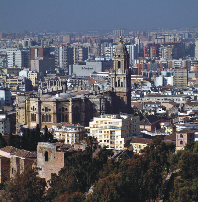
I love Malaga. I love its oldness, its newness, its back streets and its large boulevards. I go there alone very often, on foot with camera and the images I capture can be found on postcards – old doors, old windows, glimpses of a lost time.
This city is just the right size for me. I find Madrid and Seville too large, too spread out. Lovely though they are, you really need a few days to appreciate them. Whereas Malaga is a city you can spend just a few hours in, stolling along, taking time to watch its street theatre in Calle Larios.
Sometimes I go with a friend, when we visit the art galleries, the museums and the Arab Baths, then sit in one of the many squares and eat our packed lunches. Malaga does not have to be an expensive city to visit, it can be done just for the price of your bus fare! Another thing I like to do is visit the Port area….it is nice to find somewhere to sit and watch the ships go by. I have even been on a political demonstration in its main streets. This was the night after the dreadful bombing of Madrid Railway Station (and a couple of days before the last General Election). The streets were packed full of people protesting against terrorism and the war in Iraq, you couldn't find room to put a pin between us. We had the palms of our hands painted white and when the helicopters flew overhead, all the hands were raised to show we wanted peace. After which we all marched on the Town Hall to demonstrate our feelings.
Malaga is a bustling city. Have you visited the main indoor market? Hustle and bustle, masses of colour, polished fruit piled high, fresh veg, fish and meat. Loud and glorious! Or what about The Spice Shop? Here you can find every spice you can possibly want, all sorts of flour and couscous, sacks full of herbs for making tea and dried fruits by the box load. Then there are the Churches. Malaga doesn't just have its Cathedral, as around most corners or tucked away up a little street, you can find the local churches with gorgeous brickwork and imposing doors, where on most Saturdays, if you are lucky, you will see a wedding taking place
But if you want a quiet time then on the outskirts of the City of Malaga, just past The Alcazaba, there is a lovely little place to visit and think. The English Cemetery. In this bustling City, close by the Bullring, you will find this little piece of tranquillity. It's not posh, it's not tidy planted and neat. It's just quiet.
Until the foundation of this cemetery in 1831 the death of a Protestant in Spain presented a gruesome problem because such an event was not provided for. In Malaga, bodies of non-Roman Catholics were not permitted to be interred by day, but had to be taken down to the seashore at night by torchlight and buried in an upright position in the sand and then left to the mercy of the waves and the dogs.
W hen William Mark (1772-1849 and buried here) who had witnessed these scenes, was made British Consul in 1824, he set about the task of obtaining a piece of land to serve as an English Cemetery. Finally, in 1829, he was granted a plot of waste land by the Malaga authorities, a grant further strengthened by a Royal Order and the English Cemetery became a reality with the original walled cemetery being built in 1831.
The first person to be buried here was one Robert Boyd, executed in Malaga for his part in an abortive uprising in December 1831. Since then a series of British Consuls in Malaga have administered the English Cemetery, though without financial support from any government agency. Burials are no longer permitted here and now the cemetery relies entirely on private donations for its preservation.
There are over 1000 interesting graves and tombstones for you to discover of people from different nations who have found their final resting places there, plus within the oldest part are many graves, some of children, covered with cockle shells. There is also a monument and grave of 62 officers and men of the Imperial German Navy who perished in the wreck of the training ship 'Nisan' when she sank outside Malaga harbour on 16th December 1900. The authors Gerald Brenan (1894-1987) and his wife Gamel Woolsey (1899-1968) are also to be found here. Buried alongside each other you can also find the graves of four World War 2 Allied servicemen whose bodies were recovered from the sea near Marbella and re-interred in this cemetery on 2 April 1946. One of the last people to be buried here is Marjorie Grice-Hutchinson (1909 – 2003) an economist and writer, who was for many years a great supporter of the English Cemetery. It is from her little book about the Cemetery that I have gleaned a lot of my information.
The romantic melancholy of the Cemetery has found its way into the literature of many lands. For example, Hans Christian Anderson visited Malaga in 1862 and described the Cemetery as 'a little paradise'. Only last year, MalagaTown Hall erected a small statue of a sitting Hans Christian Anderson on the walkway by Calle Larios.
The cemetery grounds have also been home to St.George's Anglican Church since 1891, this was originally built as an ornamental 'lodge temple' in 1839. Church Services are held on a regular basis and, I believe, you can get married here You enter the Cemetery through the main gates and it is here that the Gate House has been turned into a small shop, selling notelets and prints of the Cemetery, books of the area, local pottery and a few plants.
I can honestly say that this small English Cemetery is well worth a visit.
Sandra Rowe



















